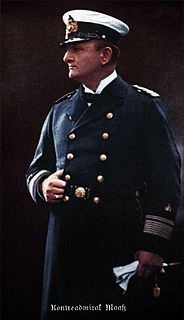This page is based on this
Wikipedia article Text is available under the
CC BY-SA 4.0 license; additional terms may apply.
Images, videos and audio are available under their respective licenses.
A light cruiser is a type of small- or medium-sized warship. The term is a shortening of the phrase "light armored cruiser", describing a small ship that carried armor in the same way as an armored cruiser: a protective belt and deck. Prior to this smaller cruisers had been of the protected cruiser model, possessing armored decks only. While lighter and smaller than other contemporary ships they were still true cruisers, retaining the extended radius of action and self-sufficiency to act independently across the world. Through their history they served in a variety of roles, primarily as convoy escorts and destroyer command ships, but also as scouts and fleet support vessels for battle fleets.
HMS Galatea, after the Galatea of mythology, has been the name of eight ships in the British Royal Navy.
Eight ships of the Royal Navy have borne the name HMS Arethusa after the Greek mythological nymph Arethusa who was transformed by Artemis into a fountain.

HMS Galatea was one of eight Arethusa-class light cruisers built for the Royal Navy in the 1910s. She fought in the First World War, participating in the Battle of Jutland. Following the war, she was scrapped.

HMS Arethusa was the name ship of her class of light cruisers built for the Royal Navy. She was built by Chatham Dockyard, with the keel being laid down on 25 January 1933. She was launched on 6 March 1934, and commissioned 21 May 1935 by Captain Philip Vian.

HMS Arethusa was the name ship of her class of eight light cruisers built for the Royal Navy in the 1910s. She saw a considerable amount of action during the early years of the First World War, participating in the Battle of Heligoland Bight and the Battle of Dogger Bank.
Several ships of the Royal Navy have been named HMS Phaeton or Phaëton after Phaëton, the son of Helios in Greek mythology:
Ten ships of the Royal Navy have been named HMS Royalist:

Leberecht Maass was the Konteradmiral who commanded the German naval forces at the first Battle of Heligoland Bight. He lost his life when his flagship, the light cruiser SMS Cöln, was sunk by British battlecruisers commanded by Vice Admiral David Beatty.

HMS Aurora was an Arethusa-class light cruiser that saw service in World War I with the Royal Navy. During the war, the cruiser participated in the Battle of Dogger Bank and was a member of the Grand Fleet when the main fleet of the Imperial German Navy surrendered to it in 1918. Following the war, Aurora was placed in reserve and in 1920, the cruiser was transferred to the Royal Canadian Navy. Her service with the Royal Canadian Navy was brief, being paid off in 1922. The cruiser was sold for scrap in 1927 and broken up.

The fourth HMS Cleopatra was a C-class light cruiser of the Royal Navy that saw service during World War I and the Russian Civil War. She was part of the Caroline group of the C class.

HMS Inconstant was one of eight Arethusa-class light cruisers built for the Royal Navy in the 1910s. She fought in the First World War, participating in the Battle of Jutland. Following the war, she was scrapped.

HMS Phaeton was one of eight Arethusa-class light cruisers built for the Royal Navy in the 1910s. She fought in the First World War, participating in the Battle of Jutland. Following the war, she was scrapped.

HMS Royalist was one of eight Arethusa-class light cruisers built for the Royal Navy in the 1910s. She fought in the First World War, participating in the Battle of Jutland. Following the war, she was scrapped.
HMS Penelope was one of eight Arethusa-class light cruisers built for the Royal Navy in the 1910s. She fought in the First World War, following the war, she was scrapped.

HMS Undaunted was one of eight Arethusa-class light cruisers built for the Royal Navy in the 1910s.










